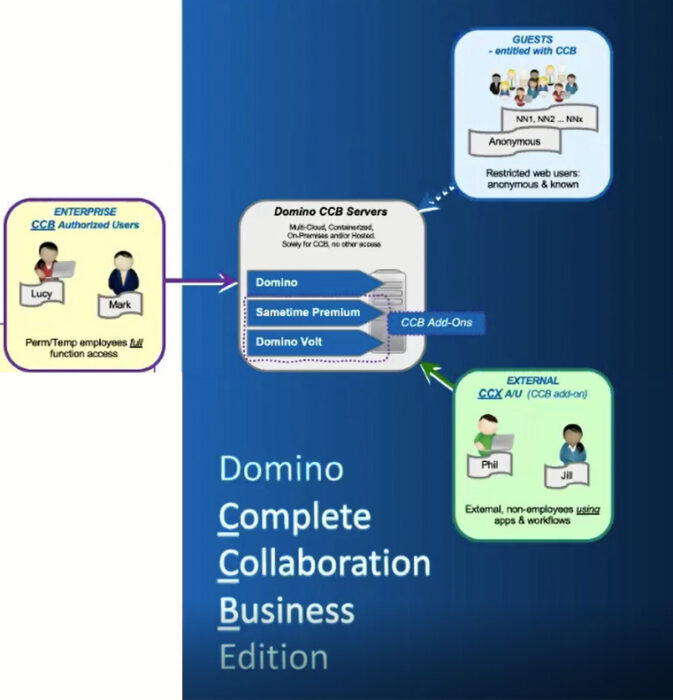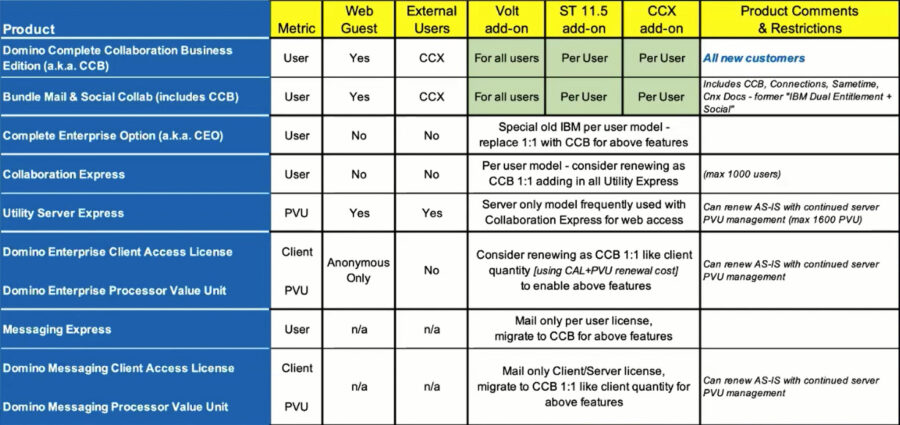With its continuing investment in growth and development of the Domino platform, HCL has made some updates to Domino licensing, which they shared in detail at Collabsphere 2020.
The licensing updates have been focused on highlighting how Domino licensing can be made easier through CCB – Domino Complete Collaboration Business Solutions.
This idea came to be mostly because customers and partners requested it:
- Eliminating the need for server capacity (PVU) based licensing and management;
- A simple, transparent way of accounting for compliance;
- Clear rules for supporting Domino users constituents internally and externally to the Enterprise
- Support anonymous use websites on Domino and provide tailored content to known Guest Users
- Permit External Users in the Enterprise B2B value chain to participate in Domino based applications and workflows
- Clear rules for extending Domino Volt to various user constituents
- Clarifying licensing for mail and calendar interoperability in multi-vendor scenarios involving our partners’ solutions.
The CCB model aims to optimize your Domino licensing:
- All employees and contractors that access Domino are CCB users;
- CCB now includes HCL SafeLinx 1.1 entitlement for all CCB users;
- CCB users all have HCL Verse enterprise class e-mail
- Transparent license management by simple CCB user counting.
CCB User Constituents
- Anonymous users who are not logged-in:
- Browse web sites
- Fill contact forms
- Anonymous blog comments
- Participate in surveys
- Known users who log-in with HTTP userid/pw are permitted to:
- Submit info/start workflow
- Special interest forums
- Add blog comments
- Read tailored content
You are able to have external users licensed via CCX add-on, thus extending apps and workflows for them.
So, they will have usage access to apps and workflows for non-employees at an attractive price. Bear in mind that CCX users can fully participate in apps and workflows but are not able to create them. Also, they can participate in task/functional e-mail, but don’t have a personal e-mail.
In order to make things even better for users CCB not only enables you to add users but functions as well through some great add-ons.
One important add-on is Sametime 11.5 Premium, which can be added on a per-user basis. Another add-on that is worth mentioning is the HCL Domino Volt one:
- CCB users build and use low-code apps
- Apps can be used by all CCX/Guest users
- Adds HCL Enterprise Integrator and SAP Connect for all Domino servers under CCB
Let’s understand CCB user classes so we get a better understanding of how they work. CCB user constituents are classified and entitled by their role.
-
Guests and known Guests are integral to an application
- Guest users are part of an app, and the reason for the app delivering value to the Enterprise licensee
- They are also entitled with the CCB paid for by the Enterprise
-
All employees and contractors in the licensee’s Enterprise that access Domino must have a CCB commitment
- CCB is priced for the value of the Domino platform to the Enterprise
- There is no difference by the functions used by specific users
- Pricing includes all Guests and enable the CCX per user add-on
-
CCX entitlement is for business partners’, customers’ and other external users’ full use of apps and workflows adding to the Enterprise value chain
- CCX is priced for the value to the Enterprise of extending the Domino app usage to external application users.

CCB is all about simplifying things for you, so it’s also configurable as you might expect.
CCB Domino servers are uniquely for the CCB constituents!
- Only entitled CCB, CCX and Guest users are permitted access: former user entitlements, like Messaging or Collaboration Express, CEO, Dual Entitlement, any Client Access License or HCL Application Access may not access CCB licensed servers.
-
CCB servers may participate in:
- Server-server replication with any licensed server;
- Mail routing (SMTP);
- Directory lookup and authentication (LDAP) for non-HCL Domino programs
- Permit access to free/busy time information
-
CCX / Guest user restrictions are managed through Domino
- CCB – are permitted full access to use and create apps;
- CCX – are permitted to use any app, but not entitled to create or maintain Domino or Domino Volt apps
- Known Guests – Read-only access, start workflows, see tailored content.
How do you count CCB users?
You need to pay attention to the user portion of your environment, thus simplifying things.
- CCB entitlements are countable – total number of directory entries permitting login, excluding CCX and Guests
- CCX entitlements are countable – total number of directory entries permitting external partners full app login
- Known Guests is a dynamic volume of non-employee users registering or being registered for your web sites = track web users permitted as Known Guests to exclude from CCB count
- Anonymous Guests are – of course – infinite.
- For V12: the Domino License Reporting tool will produce an internal report to assist you with license compliance.
How do you get to CCB?

If you have any other questions about licensing and how it can be simplified, contact us today.
